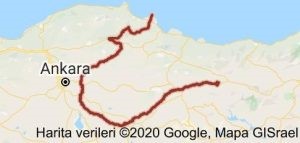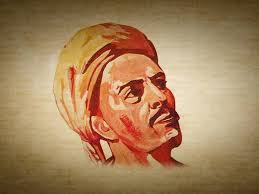Our understanding of human being at the highest level in Yunus Emre
Our investigation, which started with the Yenisey Inscriptions in the 700’s, ends with Yunus Emre (d.1321). Turkish, a treasure that is lived and transmitted with words, matured in this 6-century period, and priceless treasures were transferred to written language. ”
The values of the Turkish people have been kneaded in the Great Asia and Asia Minor geographies. Starting from epics and tombstones, then from inscriptions, until the first written Turkish book Kutadgu Bilig, people and values were scrutinized. The purpose of constantly emphasizing wisdom and wisdom in the names of people and works is the concern of perfectionism in the processing of personality. The Turks, who entered Asia Minor in the 11th century, encountered a ten thousand-year-old settled culture tradition here. Two centuries after their arrival, they revealed an age-old value like Yunus Emre.
When thousands of years of accumulation in Greater Asia was transported to Anatolia via Transoxiana and Khorasan, the same conceptual framework remained constant. The place where the mentioned accumulation is expressed most is Eskişehir lands where Yunus Emre lives. It is the same understanding of humanity that moved from the Siberian swamps to the Sakarya River. It is expressed in Yunus with an uninterrupted continuity. The unique cultural accumulation and human diversity brought by the ten thousand years of settlement in Asia Minor geography has attained a universal synthesis with the arrival of the Turks to the peninsula.
We are glad to wash our faces with Yunus Emre Divan, but the rest is obviously indecisive. What,
Spaces (air, ground, sea) will be belted when the person and the public can be themselves. The self is the key concept. Bilge Tonyukuk, Yunus Emre and Ottomans were the ones who used the concept the most.
The expressions reflected in Tonyukuk’s lines are the most poetic and assertive expressions of the self literature. It reveals itself in the first line and continues in this way until the last line. “Ben Bilge Tonyukuk” is the most concise expression of the self.
This time, Yunus Emre, one of our Sufism pioneers, who uses the concept most frequently and with emphasis after Tonyukuk, tries to express those inner values with the expression “There is a me in me”.
Person and Public Synthesis
While the concept is first encountered in the Oğuz Kağan Epic, the most intensive use is seen in Farabi and Yunus Emre. It is the energy that will arise from the integrity and unity observed. The Turks have been overseers in combining the freedom of the person and the unity of the society under state structures. Turks, who always sailed westward, differed from eastern medicine and state structures such as China, Russia, and Iran.
The freedom of the person and the inclusiveness of the public are equally important. As Yunus Emre says, the Public is the World to us. The Realm has been defined as the Public. The world outside us is a realm. The realm grasps and covers us. In Farabi, a world-human relationship was established and their interactions were emphasized.
Inscriptions, Kutadgu Bilig, Hacı Bektaş Veli, Ahmet Yesevi, Yunus Emre, Mevlana, Hacı Bektaş-ı Veli are people who have concerns and troubles on behalf of the public. It is important that we know ourselves, our people and our people well.
The concept of Public, which first appeared in the Bilge Kağan and Kül Tigin inscriptions, also appears in Kutadgu Bilig and Divan-ı Lugat it Türk. The most intensive use is expressed by Yunus Emre, as in his own concept.
The peak of the sky-voyage of the Turks, which started with the Huns leaning on the Pacific coast, will be experienced in Anatolia in Asia Minor in 1400 years. The name of this summit is Yunus Emre. Yunus Emre enlightened the skies within us with the concepts of Turkish mysticism he used, and made people in the public sphere united. He reaped the sky with Yunus. Illuminated by the sky is within the heart, it is the heart. Gönül fabric is woven in the sky.
In Mevlana, a contemporary of Yunus Emre, the Mesnevi, which is visualized with Sema (Sky) rites and Whirling Dervishes, is also related to the secrets in the sky.
Mevlana, Yunus, Köroğlu, Pir Sultan Abdal, Dadaloğöu, Âşık Veysel, Neşet Ertaş came out of the people and became folk philosophers. The roots of the Central Anatolian folk songs and music tradition are related to the ideas and arts developed by the people in Central Asia. Philosophical wisdom is constantly expressed through improvised narration.
Yunus Emre was demonstrating mysticism at the level of the people, in folk language. Mevlana, on the other hand, addressed the higher class in Persian with his “Mesnevi”, but the world and religion views of Mevlana and Yunus Emre were almost the same. The old Turkish culture, together with the folk culture and high culture, is the product of that era. Therefore, it is necessary to evaluate both together when evaluating the old.
Turkistan / Khorasan – Andalusia Synthesis: After the Turkestan / Khorasan Sufism, the struggling identity of Ibnul Arabi who migrated from Andalusia in addition to Demir Baba / Sarı Saltuk / Yunus / Mevlana / Hacı Bektaş by leaping to Anatolia and Rumelia, the colonizer Dervishes will take on both. They will cheer the continent with dervish lodges, lodges, and lodges, and they will live the unity of being both an entrepreneur and a thinker.
Maya (Yusuf Has Hacip. Yesevi. Yunus)
Within the framework of the new policy followed after the death of Atatürk, the concept of humanism in western Europe, which was based on ancient Greece, was imported and a trend that did not belong to us was tried to be reflected on Turkish thinkers within the framework of a great alienation. The Turkish thinkers here have been named as humanists, primarily Yunus Emre and Mevlana. Instead of researching their own history, Turkish so-called thinkers imitated the Humanism, which became a trend in Europe in the 1600s, and placed the Ancient Greek in their school curriculum.
In the period of inscriptions coinciding with the eighth century, we see that most of the concepts in the inscriptions of Bilge Tonyukuk, Bilge Kagan, and Kül Tigin are included in the texts. When we come to the period of writing, we see that all seven of the concepts are mentioned in both Farabi and Yunus Emre.
Considering the steppes of Inner Asia and Asia Minor from this point of view, the vast places where contact with the skies are established have been the areas where people think. Public thoughts also fed the thinkers. The Silk Road steppes in Inner Asia and the Cappadocia region and the surrounding areas in Asia Minor were the areas where the richest works of art were given in Eskişehir, Ankara, Konya, Kırşehir, Niğde, Nevşehir line. Yunus Emre, Mevlana, and Hacıbektaş Veli were the first examples that came to mind, always thinkers who grew up in the steppe.
Person Own Ash Public Generation Root Small Total
Own: Yunus, Ottoman
Könül: Farabi. Yusuf Has Hacip. Yunus Emre.
What: Our thinkers focusing on the concept of human are Farabi and Yunus Emre.
The inner essence of the human being and the personality of the personality are expressed with the verse “I have an ego in me” by Yunus.
Yunus is a wise thinker who has synthesized our understanding of human in the “person, own, public” organization, in the Turkish term of Divan-ı Lugat it is our “lofty sage”. In the written and oral works of the Turks, the pattern of “person, own, public” is used. In this mesh, two components (person, own) give way to a synthesis (public).
With Yunus Emre, who was born in Eskişehir, human existence, which was interpreted in a universal sense in the 1200s, became the subject of the war of life and death under the leadership of Atatürk for 22 days and 22 nights in the Sakarya War that took place this time in the Eskişehir-Polatlı line in the 1900s. The human philosophy that Yunus Emre embraced the hearts with his poems, this time Atatürk knew how to win heroically with blood and tears through war and strategy. Eskişehir-Polatlı was actually the destiny and destiny that brought together Yunus Emre and Atatürk at the same point of humanity.
The first result of the sovereignty of the Turkish people, which was declared to the world on April 23, 1920, was the Sakarya Victory. After setting out from the starting point of our human dignity, the first victory has been achieved in a short time. This honor, which we are in its centenary, is also the touchstone of the millennia to come.
The journey of the Turks, extending from the Old World Asia to Eskişehir, witnessed the struggle for the liberation and establishment of a new world and a new person in the same land, and the success that was repeated one year after the Battle of Sakarya was the principles of ancient Greek democracy, philosophy and thought power. The attacker who adopted the principle has revealed the hypocrisy of the West. Ancient Greek New Turkey has succeeded in losing born from the ashes.
After Atatürk won the war, Yunus Emre continued his mission by extending the hand of love and friendship to his enemies Trikopis and Venizelos. Ataturk, who made determinations about personality and human during the liberation process, was not satisfied with this, and during the establishment, he constantly brought and read books by taking advantage of his examiner feature, and based on this, he developed ideas and thoughts especially about the history of humanity and the future of humanity.
Atatürk’s ever-extinguishing source of energy has been his love of people and his love for him. Our people, who accorded Tonyukuk the title of Wise 1300 years ago, honored Mustafa Kemal with the title of Ata. The hearts of our people, full of superior values, did not go unnoticed by both leaders and made themselves masters of both pennants and swords.
Atatürk saw the future and assurance of the Turkish existence as the problem of “creating the new Turkish people.” He did not content with thinking and producing ideas on this subject, but tried and evaluated various suggestions. He tried to create a Turkish culture that would educate his people. Source: Bozkurt Güvenç: Turkish Identity.
Europe, where Atatürk constantly questioned his humanity at the beginning of the 20th century, closed the doors of the continent to humanity at the beginning of the 21st century.
The sovereignty, which has human value in its essence, has been transformed into a state power on a citizen basis starting from 23 April 1920.
Our dictionary, documented with more than 400 words in the Bilge Tonyukuk Inscription dated 720, our first written document, reaches more than 3800 words in the works of Derviş Yunus (d.1238). Our language is unique with the efforts of the wise and dervishes for 500 years.
Yunus Emre and Shakespeare
Yunus Emre is our Shakespeare. Let the theater actors adapt the plays from there. Is it difficult?
The British perform Shakespear’s works in their theaters every day. We remember Derviş Yunus only when we commemorate our dead with collective hymns.
We need to keep Yunus alive for the real living.
Verses in our language
With our rich hearts.
Our dictionary, documented with more than 400 words in the Bilge Tonyukuk Inscription dated 720, our first written document, reaches more than 3800 words in the works of Derviş Yunus (d.1238). Our language is unique with the efforts of the wise and dervishes for 500 years.
UNESCO declared 2021 as the “Yunus Emre Year” on the occasion of the 700th anniversary of his birth.
























